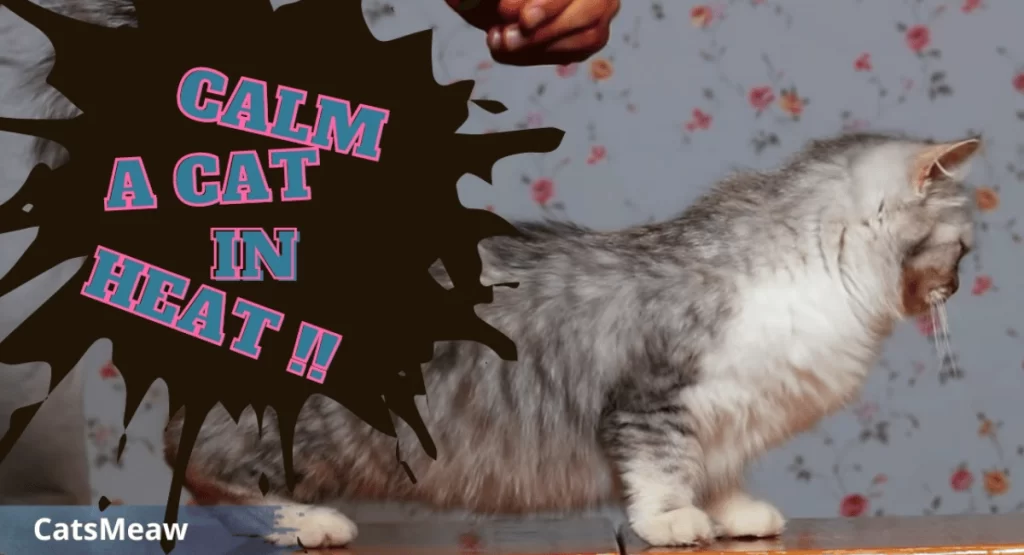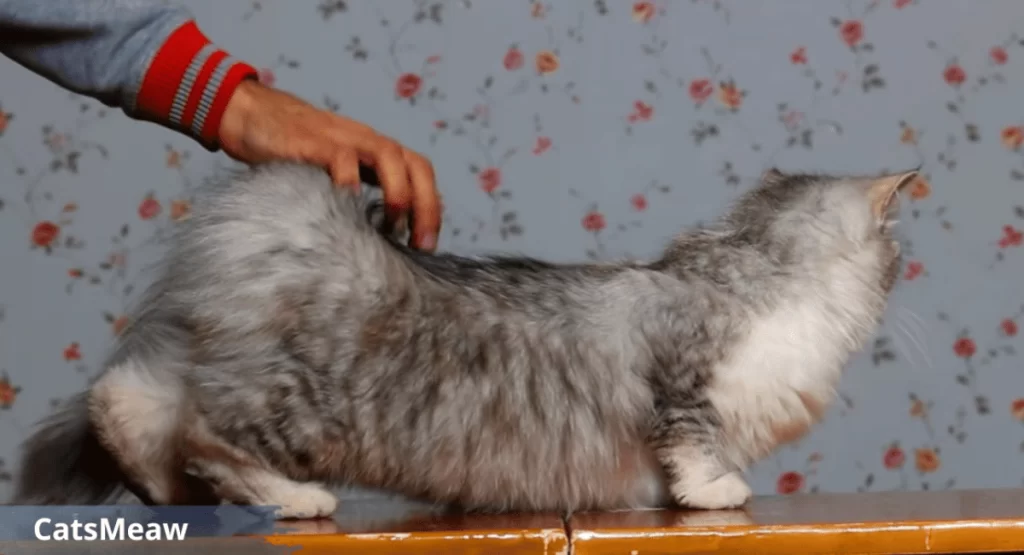It is important to understand the behavior and needs of your furry friend, especially when they are in heat. A cat in heat, also known as estrus, is a natural biological process where a female cat experiences a heightened level of sexual activity and is ready to mate.
This phase can be quite challenging for both the cat and the owner, as the cat may exhibit certain signs and behaviors that can be overwhelming. By understanding the basics of a cat in heat, you will be better equipped to provide the necessary care and support during this time.

Table of Contents
Understanding a Cat in Heat
A cat in heat typically displays several signs and symptoms that are hard to miss. One of the most remarkable signs is an increase in vocalization. Your cat may start meowing excessively, yowling, as a way to attract potential mates. This can be quite disruptive, especially during the night when you and your family are trying to sleep.
Another common symptom is a change in behavior. Your cat may become more affectionate, rubbing against furniture, people, or other animals. Additionally, you may notice that your cat is more restless and agitated, pacing around the house or constantly seeking attention. Understanding these signs will help you identify when your cat is in heat and take appropriate measures to calm her naturally.
Reasons to Calm a Cat in Heat Naturally
Now that you have a better understanding of what a cat in heat entails, let’s explore the reasons why it is important to calm your cat during this time. First and foremost, calming your cat can help alleviate her discomfort. Being in heat can be physically and emotionally distressing for your furry friend. By providing a calm and soothing environment, you can help reduce her stress levels and ensure her well-being.
Another reason to calm your cat in heat naturally is to prevent unwanted behaviors. When a cat is in heat, she may exhibit certain behaviors such as spraying urine, marking territory, or attempting to escape outside. These behaviors can be quite frustrating and disruptive to your household. By implementing natural calming techniques, you can help redirect your cat’s energy and prevent these unwanted behaviors from occurring.
Our pick: The Best Cat Health Supplies
Lastly, calming your cat in heat naturally can also benefit you as the owner. It can help improve the overall harmony and tranquility of your home. When your cat is in a calm state, it creates a peaceful environment for everyone living in the house. This can lead to better sleep, reduced stress levels, and a stronger bond between you and your cat.pl
Creating a Calm Environment for Your Cat
Creating a calm environment for your cat is crucial during her heat cycle. Here are some tips to help you achieve a peaceful atmosphere:
- Provide a Safe Space: Set up a designated area where your cat can retreat to when she needs some alone time. This space should be quiet, comfortable, and equipped with her favorite toys, blankets, and a cozy bed.
- Keep the Environment Consistent: Cats are creatures of habit and thrive in a consistent environment. Avoid making any major changes or introducing new stimuli during your cat’s heat cycle. Stick to her regular routine, including feeding times, play sessions, and sleeping arrangements.
- Minimize External Triggers: Cats in heat can be easily stimulated by external factors such as the presence of other animals or loud noises. Keep your cat away from potential triggers by closing windows, drawing curtains, and minimizing exposure to unfamiliar animals.
Related: 7 Most Dangerous Foods for Cats
By creating a calm environment for your cat, you are providing her with a safe and secure space where she can relax and feel at ease during her heat cycle.

Providing Comfort and Relaxation Techniques
In addition to creating a calm environment, there are various comfort and relaxation techniques that can help soothe your cat in heat. Here are some effective methods to try:
- Gentle Massage: Cats love being petted and stroked. Take some time each day to gently massage your cat, focusing on areas that she particularly enjoys, such as behind the ears or under the chin. This can help release tension and promote relaxation.
- Use Calming Scents: Certain scents, such as lavender or chamomile, have calming effects on cats. You can use essential oils or natural sprays to create a relaxing atmosphere in your home. However, it is important to consult with a veterinarian before using any scents, as some cats may have allergies or sensitivities.
- Provide a Warm and Cozy Environment: Cats seek warmth and comfort, especially during their heat cycle. Ensure that your cat has access to warm and cozy spots in your home, such as a heated bed or a soft blanket near a sunny window. This will help her feel relaxed and content.
By implementing these comfort and relaxation techniques, you can help your cat find solace and ease any discomfort she may be experiencing during her heat cycle.
Natural Remedies to Calm a Cat in Heat
If your cat’s behavior and discomfort persist despite providing a calm environment and relaxation techniques, you may consider using natural remedies to further alleviate her distress. Here are some effective natural remedies to calm a cat in heat:
- Herbal Supplements: Certain herbs, such as valerian root or chamomile, have calming properties that can help reduce anxiety in cats. These herbs can be found in the form of supplements or tinctures, but it is important to consult with a veterinarian before introducing any new supplements into your cat’s diet.
- Pheromone Diffusers: Pheromone diffusers release synthetic pheromones that mimic the natural scent of a mother cat. These pheromones have a calming effect on cats and can help reduce stress and anxiety. Simply plug in the diffuser in the room where your cat spends most of her time.
- Homeopathic Remedies: Homeopathic remedies, such as Rescue Remedy, can be effective in calming cats during their heat cycle. These remedies are made from natural ingredients and can be administered orally or added to your cat’s drinking water. Again, consult with a veterinarian for appropriate dosages.
It is important to note that while natural remedies can be beneficial, they may not work for every cat. If your cat’s behavior continues to be disruptive or if she shows signs of distress, it is best to consult with a veterinarian for further guidance and potential medical interventions.
Exercise and Play to Distract Your Cat
Engaging your cat in regular exercise and play sessions can be an effective way to distract her and redirect her energy during her heat cycle. Here are some tips for engaging your cat in physical activities:
- Interactive Toys: Invest in interactive toys that stimulate your cat’s hunting instincts. Toys that require her to chase, pounce, and bat can provide mental and physical stimulation. Rotate the toys regularly to keep her interested.
- Play Sessions: Dedicate specific times each day for interactive play sessions with your cat. Use toys that she enjoys, such as feather wands or laser pointers, and engage her in vigorous play. This will help tire her out and provide an outlet for her energy.
- Create an Enriched Environment: Set up an enriched environment for your cat by providing scratching posts, climbing trees, and hiding spots. This will encourage her to explore, engage in physical activity, and channel her energy in a positive way.
By incorporating regular exercise and play into your cat’s routine, you can help keep her physically and mentally stimulated, thereby reducing her restlessness and promoting a sense of calm during her heat cycle.
Related: Why Your Cat Attacks Your Feet
Conclusion
Caring for a cat in heat requires patience, understanding, and a commitment to providing a calm and soothing environment. By understanding the signs and symptoms of a cat in heat, creating a calm environment, providing comfort and relaxation techniques, using natural remedies, and engaging in exercise and play, you can help calm your cat naturally and ensure her well-being.
Remember, each cat is unique, and what works for one may not work for another. It is important to observe your cat’s behavior closely and consult with a veterinarian if needed. With your love and care, your cat can navigate through her heat cycle with ease and comfort.
